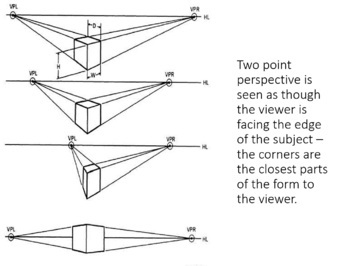Perspective Drawing
- PDF
- Google Apps™

What educators are saying
Description
*When you download this file you will be able to open it as a PDF, Google Slides Presentation, PowerPoint and more. The PDF will be downloaded first, then simply click on the link in slide #2 to see the presentation in a Google Slides Format. From there you can click File---> Download---> and convert it to PowerPoint or other desired formats.
This 107 slide presentation includes 116 images and explanations of all that perspective drawing has to offer. There are numerous real-world examples as well as plenty of finished student drawings. If you're looking for a GREAT way to introduce perspective drawing (especially 1, 2, and 3 point perspective, that this presentation is a must have. If you’re looking to explore the many different ways to use visual perspective, then this is for you too. It is constructed with the high school and middle school abilities in mind yet could be used for upper elementary or even college level.
Slides 1-6: Look at the basics of linear perspective including a review of the six illusions of space, as well as perfectly selected photos which illustrate the Vanishing Point, converging parallel lines, perspective seen both indoors and outdoors, and more.
Slides 7-13: Look at a number of artworks and artists who did NOT achieve proper perspective because it was not yet understood or mistakes were made. Prompting questions during your lecture will help students discover where these artists went wrong.
Slides 14-18: Illustrate now-famous, early accurate attempts at perspective (images include, Durer, Masaccio, Botticelli, and da Vinci),
Slides 19-32: Break down the basics of one-point perspective. Starting with simple structures, images of both inside and outdoor objects are drawn with the guidelines and vanishing points remaining so that students can see how they are constructed. There are numerous student examples of both interior and exterior perspective drawings.
Slides 33-52: Break down the basics of two-point perspective. Starting with simple structures, images of both inside and outdoor objects are drawn with the guidelines and vanishing points remaining so that students can see how they are constructed. There are numerous student examples of both interior and exterior perspective drawings.
Slides 53-65: Break down the basics of three-point perspective. Starting with simple structures, images of both inside and outdoor objects are drawn with the guidelines and vanishing points remaining so that students can see how they are constructed. There are numerous student examples of both interior and exterior perspective drawings.
Slides 66-70: Look at multi-point perspective (when there is more than one vanishing point, yet they are non-related to one another as in the previous three types
Slides 71-78: Show images of 4, 5, 6, and even 7-point perspective. Explanations for how to accomplish these advanced perspective techniques are NOT given as these types of perspective are reserved for master artists at the college level and beyond. They are shown merely to amaze the class or perhaps entice those interested in perspective the endless possibilities, as well as the more advanced and difficult side of perspective drawing.
Slides 79-89: Introduce the artwork of some modern masters of perspective including: Julian Beaver, M. C. Escher, Giovanni Piranesi, Wayne Thiebaud, and Gustave Caillebotte.
Slide 90-91: Look at some of the most amazing architecture in the world to get your students creativity flowing for what sort of structure(s) they might draw (images include: St. Basil's, Falling Water, the Rock and Roll Hall of Fame, a mosque, pagoda, Greek and Roman styles, etc.
Slides 96-106: Look at the many careers associated with artists who use perspective drawing often or exclusively (Architectural renderings, Computer game design, interior designer, product design, comics, and more).
Slide 107: Is a list of the Criteria (goals to be met) I asked my high school students to meet. It is how I grade them and, I hope it helps or directs your own methods.
I hope you enjoy this PowerPoint as much as my students and I do...enjoy!
Bo (The Art Guru)





